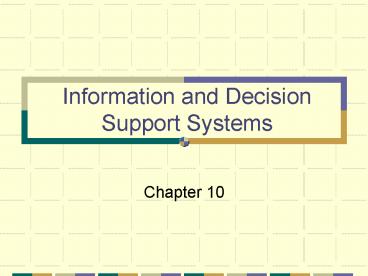Information and Decision Support Systems - PowerPoint PPT Presentation
1 / 50
Title:
Information and Decision Support Systems
Description:
List & describe the stages of a problem-solving process. ... Programmed versus Nonprogrammed Decisions. Nonprogrammed decisions ... – PowerPoint PPT presentation
Number of Views:82
Avg rating:3.0/5.0
Title: Information and Decision Support Systems
1
Information and Decision Support Systems
- Chapter 10
2
Learning Objectives
- List describe the stages of a problem-solving
process. - Define management information system (MIS) and
clearly distinguish an MIS from a TPS. - Discuss information systems in the functional
areas of businesses.
3
Learning Objectives
- Describe important characteristics of decision
support systems (DSS) - Describe the basic components of a decision
support system.
4
Learning Objectives
- State the goal of a group decision support system
(GDSS) - Identify the characteristics of a group decision
support system that distinguish it from a DSS - Identify basic uses of an executive support
system list its characteristics
5
Decision Making and Problem Solving
6
Figure 10.1
7
Programmed versus Nonprogrammed Decisions
- Programmed decisions
- Structured situations with well defined
relationships - Quantifiable
- Management information system
8
Programmed versus Nonprogrammed Decisions
- Nonprogrammed decisions
- Ill-structured situations with vague or changing
relationships between variables - Not easily quantifiable in advance
- Decision support systems
9
Problem Solving Approaches
- Optimization find the best solution
- Satisficing find a good solution
- Heuristics use rules of thumb
10
Figure 10.2
11
An Overview of Management Information Systems
12
Figure 10.3
13
Figure 10.4
14
Figure 10.4 contd
15
Table 10.1
16
Characteristics of an MIS
- Fixed format, standard reports
- Hard-copy or soft-copy reports
- Uses internal data
- User-developed reports
- Users must request formal reports from IS
department
17
Functional Aspects of the MIS
18
Figure 10.5
19
Figure 10.6
20
Figure 10.7
21
Figure 10.8
22
Manufacturing MIS
- Inventory management (MRP, JIT)
- Process control
- Computer-assisted manufacturing (CAM)
- Computer integrated manufacturing
- Flexible manufacturing system
- Quality control
23
Figure 10.9
24
Figure 10.10
25
Figure 10.11
26
Figure 10.12
27
Figure 10.13
28
Other Management Information Systems
- Accounting management information systems
- Geographic information systems (GIS)
29
An Overview of Decision Support Systems
30
Characteristics of Decision Support Systems
- Handle lots of data from various sources
- Report presentation flexibility
- Text and graphics capabilities
- Support drill down analysis
31
Characteristics of a DSS
- Complex analysis, statistics, and forecasting
- Optimization, satisficing, heuristics
- Simulation
- What-if analysis
- Goal-seeking analysis
32
Figure 10.14
33
Capabilities of a DSS
- Support all problem-solving phases
- Support different decision frequencies
- Support different problem structures
- Support various decision-making levels
34
Figure 10.15
35
Table 10.2
36
Table 10.3
37
Components of a DSS
38
Figure 10.16
39
The Model Base
- Financial models
- Cash flow
- Internal rate of return
- Statistical analysis models
- Averages, standard deviations
- Correlations
- Regression analysis
40
The Model Base
- Graphical models
- Project management models
41
Group Decision Support Systems
42
Figure 10.17
43
Characteristics of a GDSS
- Special design
- Ease of use
- Flexibility
- Decision-making support
44
Characteristics of a GDSS
- Anonymous input
- Reduction of negative group behavior
- Parallel communication
- Automated record keeping
45
Figure 10.18
46
Figure 10.19
47
Executive Support Systems
48
Figure 10.20
49
Executive Support Systems (ESS) in Perspective
- Tailored to individual executives
- Easy to use
- Drill down capabilities
- Access to external data
- Can help when uncertainty is high
- Future-oriented
- Linked to value-added processes.
50
Capabilities of an ESS
- Support for defining an overall vision
- Support for strategic planning
- Support for strategic organizing staffing
- Support for strategic control
- Support for for crisis management

